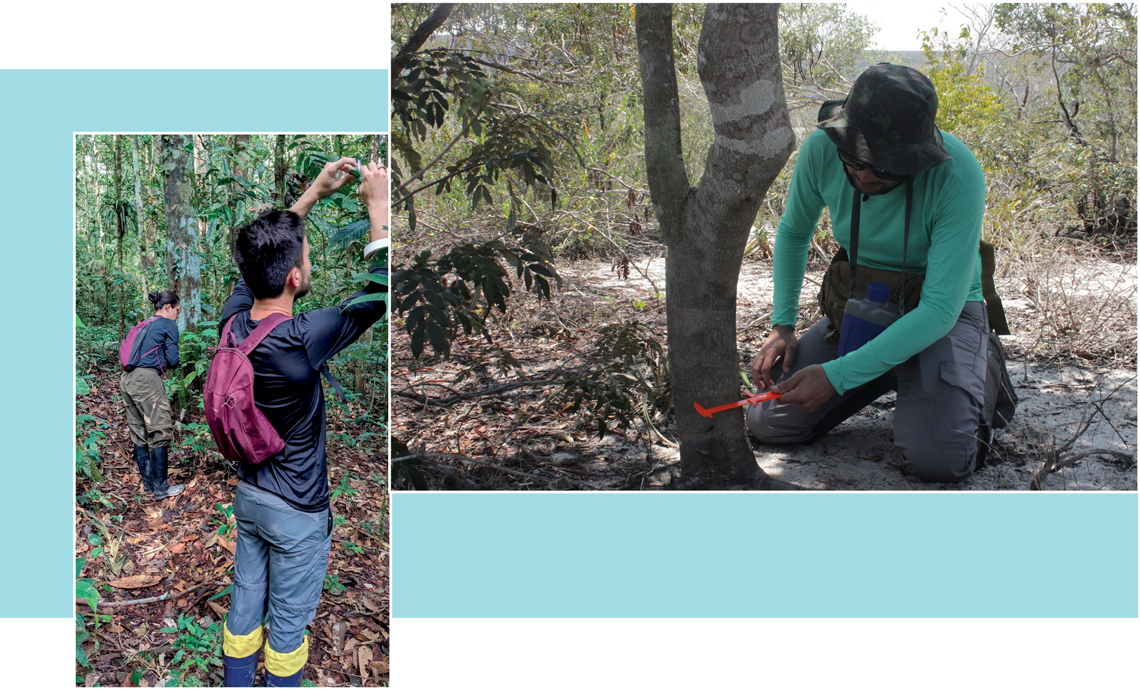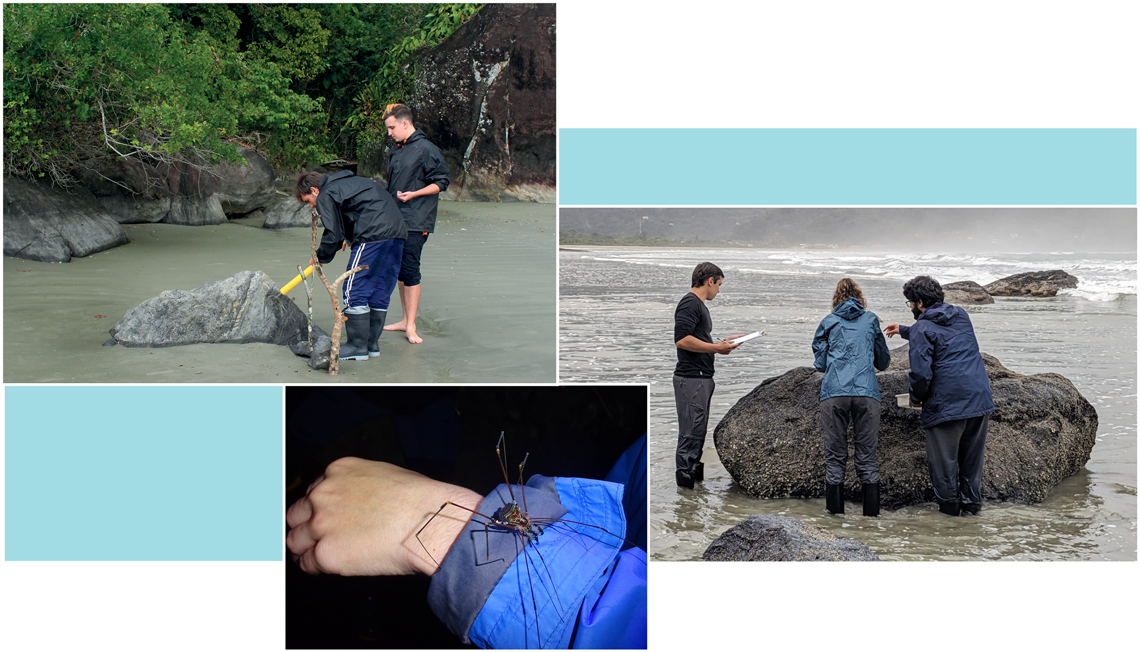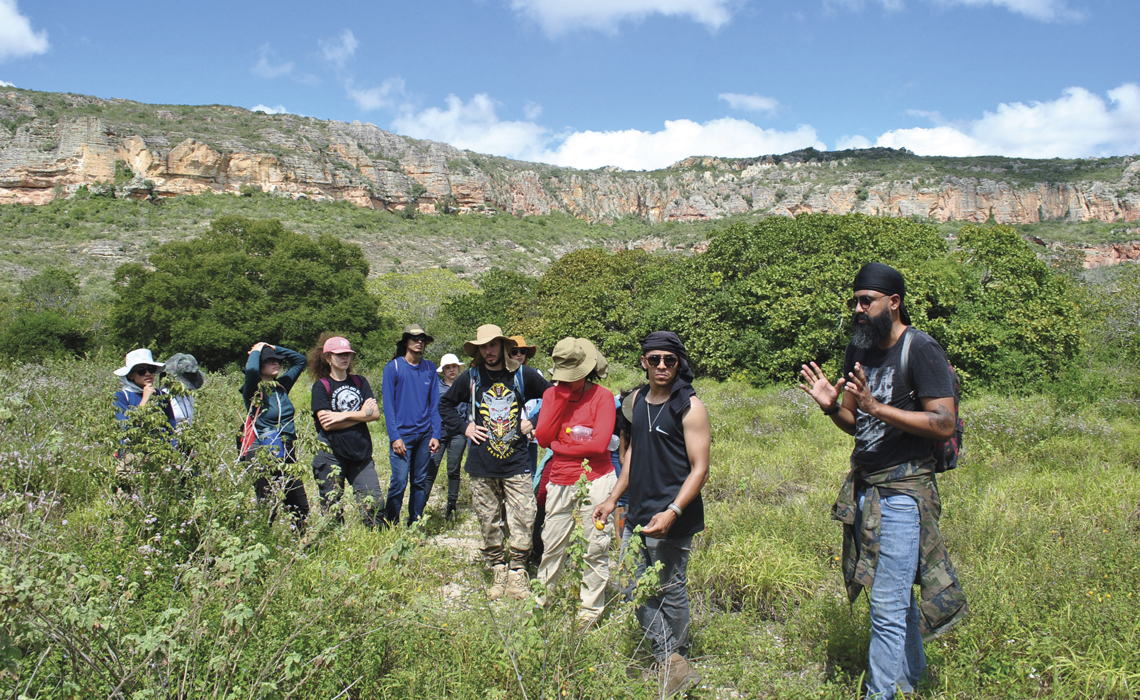Fundamental to the practical training of future researchers, field study courses in ecology are struggling in Brazil and suffer from a lack of funding. There are, therefore, fewer options for graduate students today than there were a few years ago. While Ecology of the Atlantic Rainforest, at the University of São Paulo (USP), created 17 years ago and attended by around 200 students, is not expected to return, the 28th edition of Ecology of the Amazon Rainforest (EFA)—an initiative of the National Institute of Amazonian Research (INPA)—has not yet been confirmed. “We’re looking for funding,” says biologist Flávia Delgado Santana, one of the coordinators for the EFA, which has already trained more than 500 students. The course is part of the Biological Dynamics of Forest Fragments Project (BDFFP-INPA) and is currently linked to the Federal University of Minas Gerais (UFMG).
The Atlantic Rainforest course was suspended due to lack of funding in 2019. “With the COVID-19 pandemic, it has remained suspended to this day,” says biologist Glauco Machado, of USP, and coordinator since the first edition, in 2007. “Generations of Brazilian ecologists took these courses, which have become customary in the field and enable full immersion in the rainforest and the scientific method,” says Machado, who was the EFA monitor in 2001. Machado estimates that for one edition of the course, with the usual 20 students over 28 days in places like the Cananéia-Iguape-Peruíbe Environmental Protection Area, on the southern coast of São Paulo, it would cost at least R$80,000.
As there is no permanent source of funding for both courses, keeping them afloat requires juggling. For the EFA’s 2023 edition, which cost R$120,000, according to Santana, approximately 70% of the funds came from the BDFFP, the Thomas Lovejoy Amazon Biodiversity Center, and the Paul & Maxine Frohring Foundation. Another 25% came from the Coordination for the Improvement of Higher Education Personnel (CAPES) and 5% from INPA’s graduate course in Ecology. “These percentages vary significantly each year,” notes Santana. “It began as one of the BDFFP’s human resources training branches, conceived by [US biologist Thomas] Lovejoy [1941–2021] in 1978,” she explains (see Pesquisa FAPESP issue no. 230). The students visit three to four different environments.
Combining various sources of funding is also a strategy adopted by the coordinators of the Caatinga Ecology and Conservation course, linked to the Federal University of Pernambuco (UFPE), which has trained 223 students since its first edition in 2008. Also open to students who are not enrolled at the institution, as with the EFA and the Atlantic Rainforest course, it is held in the Catimbau National Park, in Buíque, Pernambuco. Its last edition lasted two weeks, in September of 2023, with an investment of more than R$100,000.
“Some of the funds come from CAPES and some from FACEPE [Pernambuco State Science and Technology Support Foundation]. The course is a showcase for graduate students and is a product of our scientific projects,” explains one of the coordinators, biologist Inara Leal, of UFPE. The university pays for transportation to the park, and project funds pay to transport visiting professors. “Because of the low budget, there have been years when we’ve had to reduce research time, open fewer slots, and limit research to a single location.”

Serrapilheira Institute | Mikael CastroFieldwork: Searching for zombie ants in the Amazon (left), Catimbau National Park, Pernambuco (right)Serrapilheira Institute | Mikael Castro
Outstanding experience
Offered once a year, with an average of 20 participants, the immersion format is not only focused on fieldwork, but it seeks to train graduate students in the scientific method itself, with a focus on the hypothetico-deductive model. All such courses have the same inspiration: the courses run by the Organization for Tropical Studies (OTS) in Costa Rica, a nonprofit consortium created in 1963 that brings together around 50 research institutions and universities from around the world.
Immersed in the field for up to a month, students develop projects every one or two days, suggest hypotheses based on field observations, collect and analyze data, rely on mentoring from visiting professors, and write reports that they present when everyone gets together after dinner. The students are generally divided into groups at the start of the course and ultimately develop projects individually.
During the 2022 edition of the Caatinga course, one group of students had a question: how is the density of the leaves in the canopy of the umburana-de-cambão (Commiphora leptophloeos), a tree that reaches 9 meters (m) in height, associated with the exposure of the green stems that also carry out photosynthesis? They proposed the hypothesis that the loss of leaves, the main organ for photosynthesis, would be compensated by an additional increase in carbon dioxide (CO2) through these stems. As such, the students expected the trees with a lower density of leaves to have a larger number of green stems.
“But they had the opposite finding,” says Leal. After collecting and analyzing data, the group realized that the greater the density of leaves, the greater the number of green stems. “This finding indicates that the species is capable of using both carbon acquisition strategies to better maintain conditions given environmental limitations,” they wrote in their final report. According to Machado, of USP, this is an efficient way of advancing knowledge, because ideas are dismissed as hypotheses are rejected.
“We also try to show that you must deal with frustration and negative results, as well as discuss them,” adds Santana. During her graduate program in Ecology at the State University of Santa Cruz (UESC), in Ilhéus, Bahia, she participated in a field study course in Forest Ecology in southern Bahia. “The experience inspired me to pursue an academic career. I was totally immersed, practicing using the scientific method,” she recounts. “I’ve seen the same thing in the Amazon course students, who go to sleep and wake up discussing science,” she adds, noting that the experience has changed some of their research trajectories.
Leal, of UFPE, also took field study courses during her graduate program in Ecology and says she first set foot in the Amazon rainforest during the inaugural EFA class in 1993. “This piqued my interest in pursuing research even more,” she says. “I credit the course with my ability to do projects and write scientific articles.” The researcher notes that colleague and biologist Erich Fischer, of the Federal University of Mato Grosso do Sul (UFMS), was also in her class. “He went on to create the Ecology of the Pantanal field study course, which has been offered for more than 20 years.”

Serrapilheira Institute | Flávia Marquitti / UNICAMP | Amanda MacielA mollusk study on the São Paulo coast (top left), night work with opiliones and day work with mollusks in Peruíbe (to the right)Serrapilheira Institute | Flávia Marquitti / UNICAMP | Amanda Maciel
Ecologist Rafael Leitão, a UFMG professor, was a student of the 2004 EFA class. “When I took the course, during the second year of my master’s program, I saw a world of possibilities open before me when I saw how the scientific method actually works, in real time. The collaborative process is important, with discussions, surveys, and group work,” says Leitão, who is now one of the coordinators, alongside Santana.
Biologist Guilherme Corte took the Atlantic Rainforest course in 2008, during the first year of his master’s program in Ecology at the University of Campinas (UNICAMP), and he also views his fieldwork as a milestone. “It was one of the most important experiences I’ve had as a scientist,” he says. “On walks through the rainforest, the professors would say: ‘That bromeliad is on top of the tree. That’s a fact; come up with a hypothesis. We’d give it a try and they would correct us: ‘That’s not a hypothesis.’” He employs this method with undergrad students in Biology and graduate students in Environmental Sciences at the University of the Virgin Islands, in the United States. “It seems obvious, but it’s not. That’s why it’s the first class I teach. The students break into groups and go around the campus in search of three observations, three questions, and three hypotheses.”
In fact, a study conducted by ecologists from Cornell University, in the United States, sought to measure the impact that the experience had on the academic careers of graduate students in Biology and Ecology who took part in the Florida Field Study Course, offered by the institution 50 years ago. To do this, they collected data from 184 students who took part in the course and 408 who did not, searching for their publications on the Google Scholar and Web of Science platforms. The first group published 27% more scientific articles during their graduate studies than their colleagues who did not participate in fieldwork. Ten years after completing their graduate studies, they continued publishing 14% more. Those who participated in the fieldwork course were also more likely to become university lecturers, although it didn’t make much difference in their tendency to pursue a scientific career.
Using a form, the researchers also asked 131 alumni of the fieldwork course about the skills they improved through the experience. Among the main ones were conducting research in the field (43%); thinking broadly about science, curiosity, or discovery (28%); and learning by observing nature (25%). The data were published in November 2022 in the journal BioScience.
“Despite the documented benefits, university support for field courses and field stations is diminishing, such that future generations of biologists will more likely experience research in biological sciences that is isolated from its ecological context,” the article warns.
Contrary to this trend, in July of 2023, the Serrapilheira Institute decided to invest in a field study course in the Atlantic Rainforest (coordinated by Glauco Machado) and in the Amazon (coordinated by biologist Paulo Enrique Peixoto, of UFMG) for students enrolled in the Quantitative Ecology Training Course, created in 2021 and coordinated by biologist and mathematician Flávia Marquitti, of UNICAMP. The training course is open to undergrad and master’s students who are proficient in English, the official language of the classes taught by visiting professors from other countries. Marquitti attended USP’s Ecology of the Atlantic Rainforest course in 2009. “It was quite remarkable for me because it was the first time I thought of combining mathematical modeling and fieldwork. As part of my project, I created a model and tested it with data I collected,” she says.
During the field study course’s first edition, funded by the Serrapilheira Institute, 16 biology, ecology, physics, and mathematics students in their final year of undergraduate studies or students in their first year of graduate studies were selected, among 30 who were enrolled in the theoretical course, to venture into the field to implement what they had learned in the classroom. Split into groups of four students, each group with two advisors, they developed a project in either the Atlantic Rainforest or the Amazon Rainforest, over the course of seven days. The students also thought of questions, created hypotheses, collected data, developed statistical models, and presented their findings.
The budget for the 2023 field study course was R$632,000, to cover working materials, all meals, lodging, and transportation for the students, in addition to 16 professors (some from abroad), three advisors, and four tutors, who were paid. “Being in the field is transformative and results in a paradigm shift for the students, as many of them have never even set foot in the wilderness,” notes Hugo Aguilaniu, CEO of the Serrapilheira Institute. “Things happen that you could never even imagine if you didn’t see them firsthand.”
Aguilaniu notes that, although mathematical modeling and the ability to analyze large amounts of data are fundamental, they need to interact with what researchers find in nature. “Therefore, the Serrapilheira Institute believes that field study courses play an essential role in completing this cycle,” he concludes.
Scientific article
HERNÁNDEZ, L. M. A, et. al. A half century of student data reveals the professional impacts of a biology field course. BioScience. Vol. 73, no. 1, Nov. 2022.
